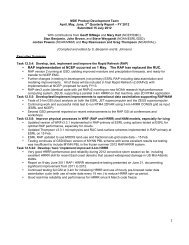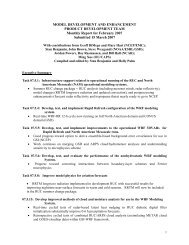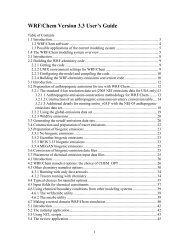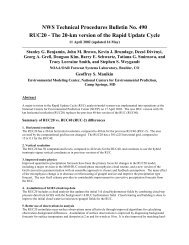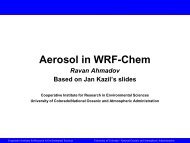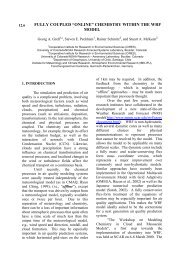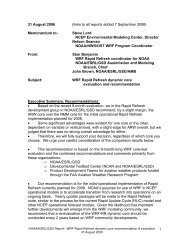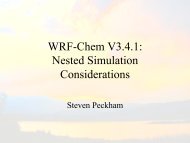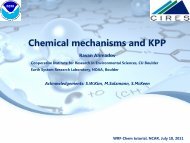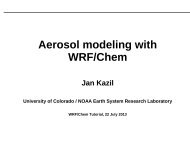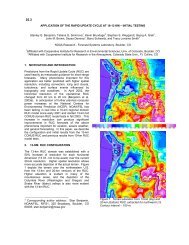1. introduction 2. snow model description 5.4 - impact ... - RUC - NOAA
1. introduction 2. snow model description 5.4 - impact ... - RUC - NOAA
1. introduction 2. snow model description 5.4 - impact ... - RUC - NOAA
You also want an ePaper? Increase the reach of your titles
YUMPU automatically turns print PDFs into web optimized ePapers that Google loves.
<strong>5.4</strong> - IMPACT OF A SNOW PHYSICS PARAMETERIZATION ON SHORT-RANGE<br />
FORECASTS OF SKIN TEMPERATURE IN MAPS/<strong>RUC</strong><br />
Tatiana G. Smirnova<br />
Cooperative Institute for Research in Environmental Sciences (CIRES)<br />
University of Colorado/<strong>NOAA</strong> Forecast Systems Laboratory<br />
Boulder, Colorado<br />
John M. Brown and Stanley G. Benjamin<br />
<strong>NOAA</strong> Forecast Systems Laboratory<br />
Boulder, Colorado<br />
<strong>1.</strong> INTRODUCTION<br />
A <strong>snow</strong> physics parameterization and <strong>snow</strong> cycling<br />
component has been added to the soil/vegetation scheme<br />
(Smirnova et al., 1997b) previously incorporated into the forecast<br />
component of MAPS (Mesoscale Analysis and Prediction<br />
System, Benjamin et al. 1996, 1997). (MAPS is implemented<br />
at the National Centers for Environmental Prediction (NCEP)<br />
as the Rapid Update Cycle or <strong>RUC</strong>.) The <strong>snow</strong> physics package<br />
accounts for the processes of <strong>snow</strong> accumulation on the ground<br />
surface and <strong>snow</strong> melting. Our goal here is to improve MAPS/<br />
<strong>RUC</strong> prediction of skin temperature and surface air temperature,<br />
and avoid the significant errors which may result even at<br />
short time scales from inaccurate forecasts of <strong>snow</strong> cover. The<br />
<strong>snow</strong> <strong>model</strong>, its testing in a 1-D framework, and implementation<br />
in the 3-D forecast scheme are discussed in the paper.<br />
Figure.1 A summary of the processes in the MAPS/<strong>RUC</strong><br />
soil/<strong>snow</strong>/vegetation scheme.<br />
<strong>2.</strong> SNOW MODEL DESCRIPTION<br />
The MAPS/<strong>RUC</strong> soil <strong>model</strong> contains heat and moisture<br />
transfer equations together with the energy and moisture budget<br />
equations for the ground surface, and uses an implicit<br />
scheme for the computation of the surface fluxes. The heat and<br />
moisture budgets are applied to a thin layer spanning the<br />
ground surface and including both the soil and the atmosphere<br />
with corresponding heat capacities and densities (Fig. 1). A<br />
concept for treating the evapotranspiration process, developed<br />
by Pan and Mahrt (1987), is implemented in the MAPS/<strong>RUC</strong><br />
soil/vegetation scheme.<br />
In the presence of <strong>snow</strong> cover, <strong>snow</strong> is considered to be<br />
an additional upper layer of soil that interacts with the atmosphere,<br />
significantly affecting its characteristics. The properties<br />
of <strong>snow</strong> are quite different from those of soil. High values of albedo<br />
reduce the amount of absorbed solar radiation, and the<br />
small thermal diffusivity in <strong>snow</strong> reduces coupling with temperatures<br />
in the soil layers below. As a result, the skin temperature<br />
may be much cooler where there is <strong>snow</strong> cover. Further,<br />
the atmospheric stratification frequently becomes stable with<br />
inversions near the ground.<br />
The <strong>snow</strong> <strong>model</strong> contains a heat-transfer equation within<br />
the <strong>snow</strong> layer together with the energy and moisture budget<br />
equations on the surface of the <strong>snow</strong> pack. This budget is applied<br />
to the entire <strong>snow</strong> layer if <strong>snow</strong> depth is less than a threshold<br />
value, currently set equal to 7.5 cm, or to the top 7.5 cm<br />
layer of <strong>snow</strong> if the <strong>snow</strong> pack is thicker. Snow evaporates at a<br />
potential rate unless the <strong>snow</strong> layer would all evaporate before<br />
the end of the time step. In this case the evaporation rate is reduced<br />
to that which would just evaporate all the existing <strong>snow</strong><br />
during the current time step. Heat flux within the <strong>snow</strong> layer is<br />
calculated with a constant value of thermal conductivity of 0.25<br />
Wm -1 K -1 , the average of values for new and old <strong>snow</strong> (Table<br />
11-3, Pielke 1984). Averaged values from the same source are<br />
used for specific heat capacity of <strong>snow</strong> (2090 J kg -1 K -1 ) and<br />
<strong>snow</strong> density (290 kg m -3 ). A heat budget is also calculated at<br />
Corresponding author address: Tatiana G. Smirnova, <strong>NOAA</strong>/<br />
ERL/FSL, R/E/FS1, 325 Broadway, Boulder, CO 80303, e-<br />
mail: smirnova@fsl.noaa.gov
the boundary between the <strong>snow</strong> pack and the soil, allowing<br />
melting from the bottom of the <strong>snow</strong> layer. Melting at the top<br />
or bottom of the <strong>snow</strong> layer occurs if energy budgets produce<br />
temperatures higher than the freezing temperature (0 o C). In<br />
this case the <strong>snow</strong> temperature is set equal to the freezing point,<br />
and the residual from the energy budget is spent on melting<br />
<strong>snow</strong>. Water from melting <strong>snow</strong> infiltrates into the soil, and if<br />
the infiltration rate exceeds the maximum possible value for the<br />
given soil type, then the excess water becomes surface runoff.<br />
The accumulation of <strong>snow</strong> on the ground surface is provided<br />
by the microphysics algorithm of the MAPS/<strong>RUC</strong> forecast<br />
scheme (Reisner et al. 1997, Brown et al. 1998). It predicts<br />
the total amount of precipitation and also the distribution of<br />
precipitation between the solid and liquid phase. The subgridscale<br />
(“convective”) parameterization scheme also contributes<br />
to the liquid precipitation. With or without <strong>snow</strong> cover, the liquid<br />
phase is infiltrated into the soil at a rate not exceeding maximum<br />
infiltration rate, and the excess goes into surface runoff.<br />
The solid phase in the form of <strong>snow</strong> or graupel is accumulated<br />
on the ground/<strong>snow</strong> surface and is unavailable for the soil until<br />
melting begins.<br />
3. ONE-DIMENSIONAL EXPERIMENTS<br />
The MAPS <strong>snow</strong> <strong>model</strong> was tested off-line in a one-dimensional<br />
(1-D) setting before incorporation into the MAPS/<br />
<strong>RUC</strong> forecast scheme. The data from six stations located in the<br />
different climatic regions of the former Soviet Union, provided<br />
by Adam Schlosser (pers. comm.) and described by Robock et<br />
al. (1995), are excellent for such testing. In these 1-D experiments,<br />
the <strong>model</strong> simulates moisture and heat transfers inside<br />
the soil, and interaction processes between the ground/<strong>snow</strong><br />
surface and the atmosphere, including surface fluxes, <strong>snow</strong> accumulation,<br />
and <strong>snow</strong> melting, driven by atmospheric forcing<br />
for a six-year period (1978-1983). The datasets for all six stations<br />
have a 3-hour frequency, and are interpolated to 30-<br />
minute intervals. The first year of simulations is repeated until<br />
an equilibrium state is reached, when the result is no longer dependent<br />
on the initial conditions. The simulated surface temperature,<br />
soil moisture, and <strong>snow</strong> water equivalent are verified<br />
against the real data to evaluate the performance of the <strong>snow</strong>melting<br />
algorithm.<br />
Figure 2 depicts various observed and simulated variables<br />
over the 6-year period for Khabarovsk, located in a moist<br />
forest area of Russia. The <strong>model</strong> captures the main features in<br />
the seasonal variations of soil moisture and also demonstrates<br />
consistency with precipitation events and periods of active<br />
<strong>snow</strong> melting. The <strong>snow</strong> water equivalent also appears to be in<br />
good agreement with observations. There are two main seasonal<br />
spikes in the moisture available for infiltration into soil (Fig.<br />
2a): the first is in spring when the <strong>snow</strong> is melting, and the second<br />
is in the fall and is related to the precipitation maximum at<br />
that time. The driest periods of the year are the end of summer<br />
and winter. Similar features can be traced in the soil moisture<br />
content of the top 1 m (Fig. 2b), where there is also generally<br />
good agreement between the <strong>model</strong> and observations. The exception<br />
is 1980, when observed soil moisture values in spring<br />
and fall far exceeded both field capacity and <strong>model</strong> simulations.<br />
The year 1980 also had an abnormally large seasonal variation<br />
of observed soil moisture in comparison to the other five years.<br />
We can only speculate that the uncertainty of determining soil<br />
hydraulic properties in the <strong>model</strong> and the disregard of variation<br />
with depth of soil properties such as porosity and density may<br />
play an important role in this extreme situation, and yet provide<br />
reasonable performance of the <strong>model</strong> in other situations.<br />
.<br />
1978 1979 1980 1981 1982 1983<br />
1978 1979 1980 1981 1982 1983<br />
1978 1979 1980 1981 1982 1983<br />
Figure <strong>2.</strong> MAPS 1-D <strong>model</strong> results and observations<br />
from 1978-83 for Khabarovsk, Russia. a) Accumulation (mm)<br />
of observed precipitation and simulated runoff and <strong>snow</strong> melt;<br />
b) volumetric soil moisture in top 1 m of soil; and c) observed<br />
and simulated <strong>snow</strong> water equivalent over 10-day periods.<br />
a<br />
b<br />
c
The performance of the MAPS/<strong>RUC</strong> soil/<strong>snow</strong>/vegetation<br />
scheme in dry climatic conditions is also tested. Data from<br />
Uralsk, located in the semiarid continental area of Kazakhstan,<br />
is appropriate for this purpose (Fig. 3 a,b,c). The small annual<br />
precipitation at Uralsk usually has a minimum during the warm<br />
season. The precipitation forcing in the 1-D experiments is the<br />
water equivalent of observed precipitation, and the 1-D <strong>model</strong><br />
considers it to be <strong>snow</strong> if the atmospheric temperature is below<br />
freezing. This assumption works better for the regions with<br />
steady <strong>snow</strong> cover and low temperatures in winter. But, for<br />
Uralsk with its significant temperature variations, <strong>snow</strong> which<br />
in fact may fall at temperatures slightly above 0 o C might be incorrectly<br />
designated as rain. This could explain the underestimation<br />
of <strong>snow</strong> water equivalent (Fig. 3c). The <strong>snow</strong> melting<br />
process at this location takes place during the entire cold season<br />
(Fig. 3a), and not just in spring or early fall as at Khabarovsk<br />
(Fig. 2a). The simulated moisture volume in the top1mofsoil<br />
has spikes in the cold seasons corresponding to the spikes of<br />
<strong>snow</strong> melt or precipitation (Fig. 3b). In most cases the response<br />
is adequate, although in January 1979 and December 1980 it is<br />
slightly overestimated. This behavior may be improved by taking<br />
into account frozen soil physics, which reduces moisture infiltration<br />
into frozen soil. In summertime, soil moisture content<br />
drops to the wilting point level as happens in reality, but changes<br />
corresponding to the summer precipitation events have less<br />
amplitude than the observed soil moisture.<br />
Experiments were also conducted for four other stations,<br />
and overall the <strong>model</strong> demonstrated good performance of<br />
its <strong>snow</strong>-accumulating and <strong>snow</strong>-melting algorithms both in<br />
dry and wet climates. This off-line testing of the soil/<strong>snow</strong>/vegetation<br />
scheme was the basis for its incorporation into the 40km<br />
MAPS three-dimensional forecast scheme running in real time.<br />
In April 1996, the multilevel soil/vegetation <strong>model</strong> was<br />
introduced into the continuously running MAPS assimilation<br />
system. The soil temperature and volumetric water content<br />
fields, as predicted by the soil <strong>model</strong>, have been allowed to<br />
evolve in the MAPS 3-hourly assimilation cycle over the 18<br />
months (as of this writing) since that time. Because there is not<br />
yet a high-frequency, national domain precipitation analysis<br />
available in real time, it is necessary to depend on the MAPS 3-<br />
hourly precipitation forecasts for precipitation input. A <strong>description</strong><br />
of the evolution of MAPS soil fields is presented by<br />
Smirnova et al. (1997; also available on-line at http://<br />
maps.fsl.noaa.gov/papers/smirnova/ams97_feb.newgif.html)<br />
Since January 1997, a <strong>snow</strong> <strong>model</strong> with accumulation<br />
and melting processes and a full energy budget has been running<br />
in the real-time MAPS. This scheme was made possible<br />
by the addition in the same month of a relatively sophisticated<br />
cloud microphysics scheme (the level 4 scheme from the<br />
NCAR/Penn State MM5 research <strong>model</strong>, Reisner et al. 1997,<br />
Brown et al. 1998), allowing for the formation, transport and<br />
fallout of cloud water and cloud ice as well as rain, <strong>snow</strong>, graupel,<br />
and the number concentration of cloud ice particles. The<br />
scheme assumes an exponential distribution of precipitation<br />
particles and permits the coexistence at a grid point, if the temperature<br />
is between 0 ° and -40 ° C, of both water and ice hydrometeors.<br />
Along with the <strong>introduction</strong> of this scheme, a<br />
hydrometeor cycling capability has been added to MAPS, so<br />
that cloud fields from the previous 1-h forecast are used to initialize<br />
each new forecast, minimizing cloud spin-up.<br />
1978 1979 1980 1981 1982 1983<br />
a<br />
b<br />
4. THREE-DIMENSIONAL APPLICATION<br />
1978 1979 1980 1981 1982 1983<br />
c<br />
c<br />
1978 1979 1980 1981 1982 1983<br />
1978 1979 1980 1981 1982 1983<br />
Figure 3. Same as Fig. 2 but for Uralsk, Kazakhstan.
From January through March 1997, the <strong>snow</strong> fields in<br />
MAPS were allowed to cycle over each 24-h period, with an<br />
update of the <strong>snow</strong> depth field occurring once daily from the<br />
USAF <strong>snow</strong> cover analysis. That analysis was a large improvement<br />
over using no <strong>snow</strong> cover at all, but has shown serious<br />
problems in certain situations such as continuous low cloud<br />
cover. Since early March 1997 through the end of May, the<br />
USAF analysis has been unavailable and, consequently, the<br />
<strong>snow</strong> cover field in MAPS has been allowed to cycle independently,<br />
as have the soil moisture and temperature fields. The results<br />
of this test (forced by external circumstances) have been<br />
very satisfactory, and suggest that, even with an improved <strong>snow</strong><br />
analyses in the future, <strong>model</strong> forecast <strong>snow</strong> information should<br />
be combined with observation-based analyses to determine optimal<br />
<strong>snow</strong> fields.<br />
Figures demonstrating the <strong>impact</strong> of <strong>snow</strong> physics parameterization<br />
on the forecast of skin and surface air temperature<br />
in the ongoing MAPS assimilation cycle will be presented<br />
at the meeting.<br />
5. CONCLUDING REMARKS<br />
Off-line one-dimensional testing of our soil/<strong>snow</strong>/vegetation<br />
scheme with <strong>snow</strong> accumulation and melting processes<br />
and a full energy budget has been undertaken on the data from<br />
several Russian stations. The <strong>model</strong> has demonstrated good<br />
performance in capturing the main features in seasonal changes<br />
of soil moisture and in the simulation of <strong>snow</strong> accumulation<br />
and <strong>snow</strong> melting. Further improvement of its results may be<br />
achieved by more accurate treatment of soil properties with the<br />
possibility of changing these properties with depth, by defining<br />
<strong>snow</strong> characteristics as a function of the <strong>snow</strong> age, and also by<br />
the incorporation of frozen soil physics into the current version<br />
of the scheme.<br />
The soil/<strong>snow</strong>/vegetation <strong>model</strong> has a 9-month history<br />
(as of this writing) since its implementation into the ongoing 3-<br />
D MAPS cycle. Qualitative verification of soil moisture, <strong>snow</strong><br />
accumulation, and <strong>snow</strong> melt fields shows that these fields, in<br />
general, are quite realistic. Further, low-level atmospheric temperature<br />
forecasts are generally improved in regions of <strong>snow</strong><br />
cover, particularly in areas of recent <strong>snow</strong>fall or rapid melting.<br />
Eleventh Conference on Numerical Weather Prediction,<br />
Norfolk, VA, Amer. Meteor. Soc., 161-163.<br />
Brown, J. M., T. G. Smirnova, and S, G, Benjamin, 1998:<br />
Introduction of MM5 level 4 microphysics into the<br />
<strong>RUC</strong>-<strong>2.</strong> Twelfth Conference on Numerical Weather<br />
Prediction, Phoenix, AZ, Amer. Meteor. Soc., (Paper<br />
4A.4).<br />
Pan, H.-L. and L. Mahrt, 1987: Interaction between soil<br />
hydrology and boundary-layer development. Bound.-<br />
Layer Meteorol., 38, 185-20<strong>2.</strong><br />
Pielke, R. A., 1984: Mesoscale meteorological <strong>model</strong>ing. Academic<br />
Press, San Diego, CA, 612 pp.<br />
Reisner, J., R. M. Rasmussen, and R.T. Bruintjes, 1997:<br />
Explicit forecasting of supercooled liquid water in<br />
winter storms using a mesoscale <strong>model</strong>. Quart. J. Roy.<br />
Meteor. Soc., in press.<br />
Robock, A., K. Ya. Vinnikov, and C. A. Schlosser, 1995: Use<br />
of midlatitude soil moisture and meteorological observations<br />
to validate soil moisture simulations with biosphere<br />
and bucket <strong>model</strong>s. J. of Climate, 8, 15-35.<br />
Smirnova, T. G., J. M. Brown, and S. G. Benjamin, 1997a:<br />
Evolution of soil moisture and temperature in the<br />
MAPS/<strong>RUC</strong> assimilation cycle. 13th Conference on<br />
Hydrology, Long Beach, CA, Amer. Meteor. Soc., 172-<br />
175.<br />
Smirnova, T. G., J. M. Brown, and S. G. Benjamin, 1997b:<br />
Performance of different soil <strong>model</strong> configurations in<br />
simulating ground surface temperature and surface<br />
fluxes. Mon. Wea. Rev., 125, 1870-1884.<br />
6. REFERENCES<br />
Benjamin, S.G., J.M. Brown, K.J. Brundage, D. Devenyi, D.<br />
Kim, B.E. Schwartz, T.G. Smirnova, T.L. Smith, and<br />
A. Marroquin, 1997: Improvements in aviation forecasts<br />
from the 40-km <strong>RUC</strong>. 7th Conference on Aviation,<br />
Range, and Aerospace Meteorology, Long Beach,<br />
CA, Amer. Meteor. Soc., 411-416.<br />
Benjamin, S. G., J. M. Brown, K. J. Brundage, D. Devenyi, B.<br />
Schwartz, T. G. Smirnova, T. L. Smith, and F.-J.Wang,<br />
1996: The 40-km 40-level version of MAPS/<strong>RUC</strong>.



